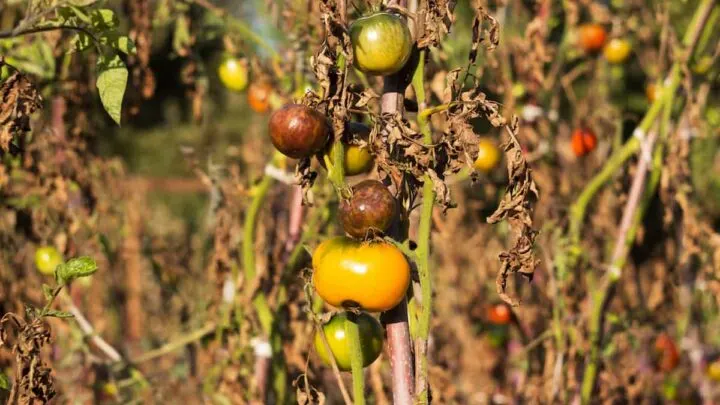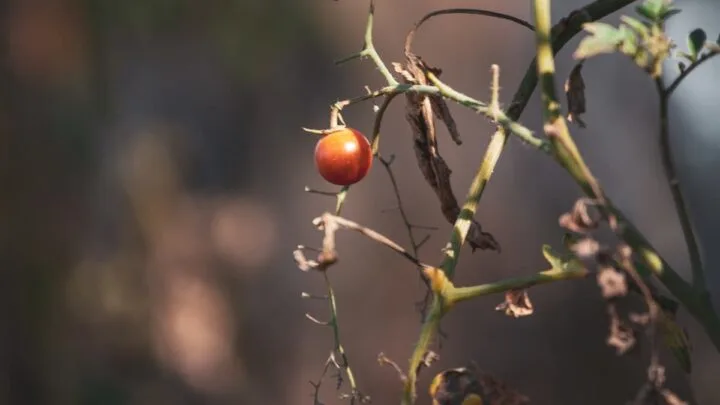Growing tomatoes can be very rewarding, but it has its share of issues. Especially when it comes to disease, tomato stems tend to have more problems than I’ve been able to count in my years growing them.
Tomato plants are particularly susceptible to a vast number of fungal diseases as well as non-fungal issues. If you’re experiencing issues with tomato stems, read on to see what might be affecting your plant.

Bumps
If you’ve grown tomatoes before, you’ve probably already seen this and are now wondering why it happens. If this is your first-time growing tomatoes, understandably, it can be quite alarming the first time you notice it. Although it can be unsightly, bumps on tomato stems are common and expected.
The bumps you are observing are roots. As you might have observed, the lower stems of the tomato plants are hairy. When those hairy stems are covered with dirt, they grow into roots. The part of the stem that doesn’t get covered with dirt turn into those tiny white bumps when the plant becomes stressed.
Typical stresses that can cause bump growth is poor drainage, over watering, internal injuries, and root damage. These can block the flow of hormones in the plant’s vascular system. The bumps emerge when the hormones accumulate at the site of the blockage. While the bumps are caused by stress, it doesn’t mean that the plant is sick or indicate the need to do anything about it since they are usually harmless to the plant.
When are bumps harmful?
They are excessive – If the bumps on the plant seem excessive, the plant could have been exposed to a herbicide. Herbicides are meant to kill unwanted vegetation, and tomatoes are quite sensitive to them. Look for other issues like curled leaves and leaves that appear yellow as if they have been bleached to confirm herbicide damage.
There are other symptoms- If the plant’s growth seems stunted and the leaves are browning in addition to the bumps, this may indicate damage to the plant roots. Wilting and bumps may indicate some wilting tomato disease. More on this below.
Splitting
The splitting of tomato stems usually indicates that the plant needs physical support. Tomato stems are not very strong and can become easily affected by the weight of the plant, especially as the fruit grows bigger. Essentially, weight stress can be exacerbated by the wind blowing into a tomato plant that is already struggling due to the excess weight.
Provide support – Stake tomato plants while they are still young. They won’t need it yet, but you can avoid damaging the roots later on by driving a stake or cage into the ground after the plant has been established. Loosely tie the tomato vine with a soft material to the stake or cage every 8 inches of growth. Offer extra support if the plant seems to be weighted down by the tomato fruit.

Wrapping – A severely split stem can be aided by splinting it or wrapping it with grafting tape. Tie the tomato stems above to the split area to avoid exacerbating the issue. Plows are amazing if the split isn’t severe, and the stem will probably heal itself.
Other less common reasons for stem splitting are insect activity and overwatering. Some insects can split stems horizontally rather than vertically; for instance, cutworms will saw through the stem just above the surface of the soil until the plant is broken. In terms of overwatering, plants will show other signs of watering first, like wilting but stems splitting open from too much intake does occasionally happen.
Discoloration
Keep in mind that some tomato varieties may have different shades of green stems. If sections of the tomato stems, particularly the lower parts, are turning brown, this indicates a fungal infection such as stem rot. A fungicide applied immediately when the issue is recognized may help, but the outlook isn’t great. You may want to rip out the affected plant to avoid infecting nearby plants.
Spots
Early blight – Dark or black spots on the stems which spread to the leaves indicate Early Blight
Late blight – Dark or black spots that start at the leaves and then spread to the stems indicate Late Blight.
Both blights are fungal diseases, and Late Blight is harder to treat. The easiest approach to treat blight is by applying fungicides containing ingredients such as copper as a preventative measure. Suppose the idea of store-bought fungicide is unappealing.
In that case, homemade fungicides made from ingredients like baking soda have reportedly been successful at preventing and treating early-stage tomato blight. In addition, all infected leaves and fruit should be cut and discarded to reduce fungal spores that spread blight.

White “Stuff”
Powdery Mildew – Often, this will affect not just the stems but also the plant’s leaves. It appears as a white powdery film covering the plant. When touched, it may leave residue on the hands. This is caused by heat, high humidity, and or wet leaves. It may not have even necessarily started with the tomato plants.
Other garden plants like squashes are susceptible to powdery mildew and can spread to other plants. Powdery mildew will eventually take over the whole plant and then kill it. The sooner it can be treated; the more likely the plant will survive.
There are sprays and oils like neem oil which can treat powdery mildew. They should be applied to both the top and underside of the leaves and stems. Cut off very affected foliage. You may also want to cut off foliage to increase airflow, as this will help alleviate some of the problems. Also, avoid wetting plant leaves when watering. Always water at the soil line.
Timber Rot or Sclerotinia Stem Rot (White Mold)– Timber Rot first affects the plant’s stems and is a more serious issue than powdery mildew. It appears as a raised, white fluff and can be mistaken for insect activity. Unfortunately, Timber Rot isn’t treatable.
The best option is to cut down the plant, avoid contact with other plants and discard it. Planting in the same soil may also be an issue since the disease can survive in the soil for many years. On the bright side, this isn’t a very common issue for home gardens.
Lesions
Lesions are areas where dark spots appear but also with evidence of some sort of injury to the plant. It can look like an open wound, sore, or an area where the dark spot isn’t on the stem but rather, the stem has turned dark.
Alternia Stem Canker – Alternia stem canker causes dark lesions on stems at the soil line. The spots enlarge, forming cankers. It later affects the fruit.
Bacterial Canker – Bacterial canker causes dark lesions and a brown streaking pattern on any part of the plant stems. The leaves and stems also become affected.
Both Alternia and Bacteria Canker can be hard to diagnose since the symptoms are similar to other tomato diseases. Treatment for infected plants includes removing the affected leaves and fruit. Apply a fungicide, though plant recovery is not guaranteed.
Finally, practicing proper plant culture is the best way to prevent tomato plant issues. This includes things like cleaning tools after use, watering at the soil line, avoiding getting leaves wet or muddy, pruning bushy plants, planting or staking tomato plants in ways that always allow airflow and keep leaves from dragging on the ground, rotating crops locations each year if possible and weeding.

Hi there, my name is Allie and welcome to my blog; GareningWithAllie!
Much of what you see written here is just our personal experiences with gardening. Along with the content I write here, there is also a unique collection of gardening topics covered by some of our close friends. I hope you find everything you read here to be helpful, informative, and something that can make your gardening journey the most lovely experience ever! With that said, Happy Gardening!
